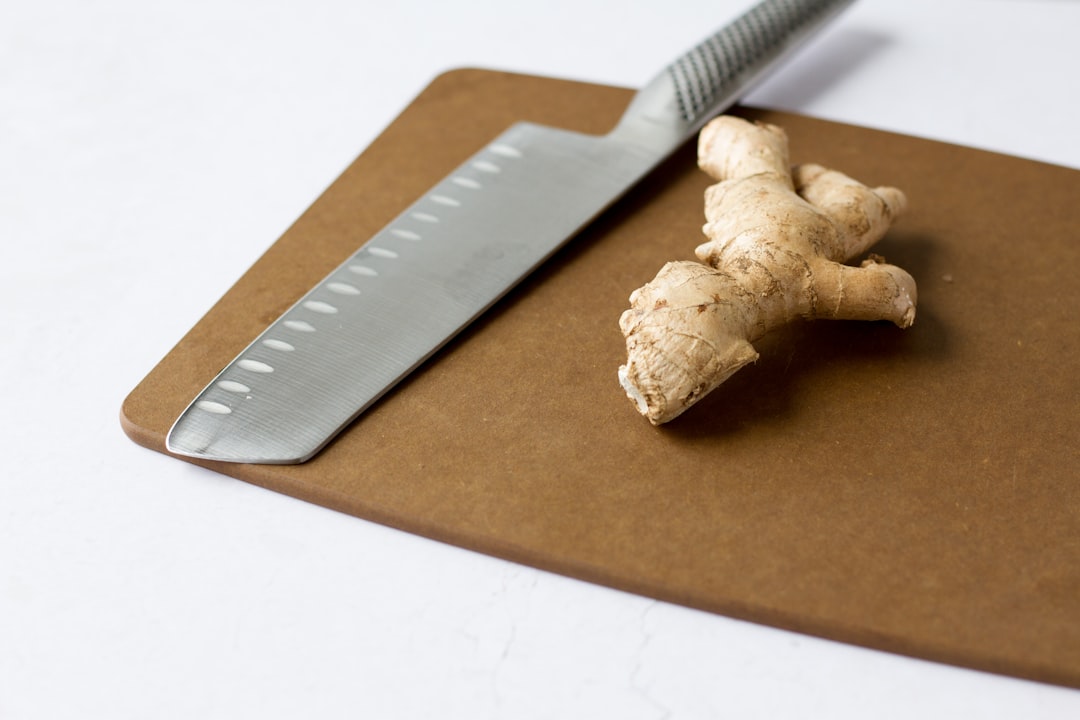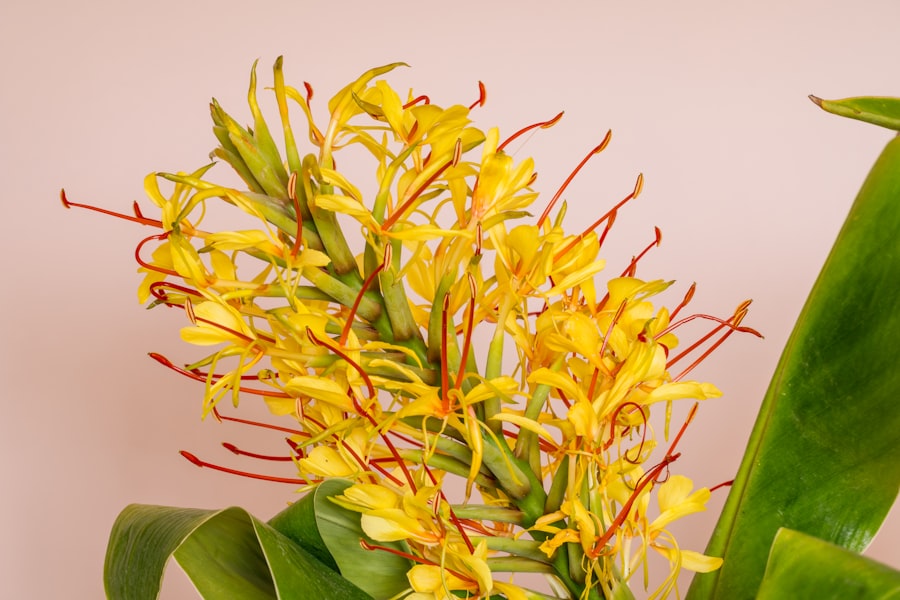Growing Ginger: Tips for a Thriving Harvest

Ginger, scientifically known as Zingiber officinale, is a tropical plant that has been cultivated for centuries for its culinary and medicinal uses. It is native to Southeast Asia and has a long history of cultivation in countries like India, China, and Thailand. Ginger is a versatile plant that can be grown in a variety of climates and soil conditions, making it an ideal choice for home gardeners.
There are several benefits to growing ginger at home. First and foremost, it allows you to have a fresh supply of ginger on hand whenever you need it. Fresh ginger has a more vibrant flavor and aroma compared to store-bought ginger, which is often dried or processed. Additionally, growing ginger at home gives you control over the growing conditions and ensures that no harmful chemicals or pesticides are used.
Choosing the Right Ginger Variety for Your Garden
When it comes to choosing the right ginger variety for your garden, there are several options to consider. The most common type of ginger is known as “culinary ginger” or “common ginger.” This variety has a mild flavor and is often used in cooking and baking. Another popular variety is “baby ginger,” which is harvested when the rhizomes are still young and tender. Baby ginger has a milder flavor compared to common ginger and is often used in pickling or as a garnish.
Factors to consider when choosing a ginger variety include the climate in your area, the available space in your garden, and your personal preferences. Some varieties of ginger are more suited to tropical climates, while others can tolerate cooler temperatures. It’s also important to consider the size of the plants and how much space they will require to grow.
Soil Preparation for Growing Ginger: Tips and Techniques
Ginger plants thrive in well-draining soil that is rich in organic matter. Before planting ginger, it’s important to prepare the soil to create the ideal growing conditions. Start by removing any weeds or grass from the planting area. Then, loosen the soil with a garden fork or tiller to a depth of about 12 inches. This will help improve drainage and allow the ginger roots to penetrate the soil more easily.
Next, amend the soil with organic matter such as compost or well-rotted manure. This will help improve the soil structure and provide essential nutrients for the ginger plants. Spread a layer of organic matter over the planting area and mix it into the soil using a garden fork or tiller. Aim for a soil pH of 6.0 to 7.0, which is slightly acidic to neutral.
Planting Ginger: Best Practices for Optimal Growth
| Best Practices for Planting Ginger | Metric |
|---|---|
| Soil Type | Well-draining soil with pH between 5.5 and 6.5 |
| Planting Time | Spring or early summer |
| Spacing | 6-8 inches apart, with rows 12-16 inches apart |
| Depth | Plant rhizomes 1-2 inches deep with buds facing up |
| Watering | Keep soil moist but not waterlogged |
| Fertilization | Apply balanced fertilizer every 4-6 weeks |
| Harvesting | Wait until leaves turn yellow and die back before harvesting rhizomes |
Timing and spacing are important factors to consider when planting ginger. Ginger is typically planted in the spring, after the last frost date in your area. The rhizomes should be planted about 2 to 4 inches deep, with the buds facing up. Space the rhizomes about 8 to 12 inches apart, allowing enough room for the plants to spread out as they grow.
It’s also important to provide some shade for the ginger plants, especially during hot summer months. You can use shade cloth or plant them in a location that receives partial shade throughout the day. This will help prevent the plants from getting scorched by direct sunlight.
Watering and Fertilizing Ginger: Dos and Don’ts
Proper watering is essential for ginger plants, as they require consistent moisture but do not tolerate waterlogged conditions. Water the plants deeply once or twice a week, depending on the weather conditions. Aim to keep the soil evenly moist but not soggy.
When it comes to fertilizing ginger, it’s best to use organic fertilizers that are high in nitrogen and potassium. Avoid using synthetic fertilizers, as they can harm the beneficial microorganisms in the soil. Apply a balanced organic fertilizer, such as compost or well-rotted manure, at the time of planting and again every 4 to 6 weeks throughout the growing season.
Managing Pests and Diseases in Ginger Plants

Like any plant, ginger is susceptible to pests and diseases. Some common pests that can affect ginger plants include aphids, spider mites, and root-knot nematodes. These pests can cause damage to the leaves, stems, and roots of the plants.
To control pests in ginger plants, it’s important to practice good garden hygiene. Remove any weeds or debris from the garden area, as these can harbor pests. You can also use natural pest control methods such as insecticidal soap or neem oil. These products are safe to use on edible plants and can help control aphids and spider mites.
Harvesting Ginger: When and How to Harvest for Maximum Yield
Ginger is typically harvested when the leaves start to turn yellow and die back. This usually occurs about 8 to 10 months after planting, depending on the variety and growing conditions. To harvest ginger, carefully dig around the base of the plant with a garden fork or shovel. Lift the rhizomes out of the ground, being careful not to damage them.
After harvesting, gently brush off any excess soil from the rhizomes. Allow them to dry in a cool, dry place for a few days before storing or using them. Freshly harvested ginger can be stored in a cool, dark place for several weeks.
Storing and Using Fresh Ginger: Tips and Tricks
To store fresh ginger, wrap it in a paper towel or place it in a paper bag and store it in the refrigerator. This will help keep it fresh for longer. Alternatively, you can freeze fresh ginger for up to 6 months. Simply peel and grate the ginger, then place it in an airtight container or freezer bag before freezing.
Fresh ginger can be used in a variety of ways in cooking and home remedies. It adds a unique flavor and aroma to dishes and can be used in both sweet and savory recipes. Ginger can also be used to make tea, infused water, or homemade remedies for digestive issues or cold and flu symptoms.
Propagating Ginger: How to Grow Ginger from Rhizomes
If you want to grow more ginger plants, you can propagate them from rhizomes. To do this, select healthy rhizomes from mature ginger plants. Cut the rhizomes into sections, making sure each section has at least one bud or “eye.” Plant the sections in pots or directly in the garden, following the same planting techniques as before.
It’s important to note that ginger plants take several months to grow and mature, so be patient when propagating ginger. The newly planted rhizomes will take some time to establish roots and start growing.
Common Mistakes to Avoid When Growing Ginger at Home
While growing ginger at home is relatively easy, there are some common mistakes that can hinder its growth. One common mistake is overwatering the plants, which can lead to root rot and other fungal diseases. It’s important to provide consistent moisture but avoid waterlogged conditions.
Another mistake is planting ginger too deep or too shallow. The rhizomes should be planted about 2 to 4 inches deep, with the buds facing up. Planting them too deep can prevent them from sprouting, while planting them too shallow can expose them to drying out.
Conclusion: Recap of key points and encouragement to try growing ginger at home.
In conclusion, growing ginger at home can be a rewarding experience. With the right variety, soil preparation, planting techniques, and care, you can enjoy a fresh supply of ginger right from your garden. Whether you use it in cooking, baking, or for its medicinal properties, ginger is a versatile plant that is worth growing. So why not give it a try and start your own ginger garden today?



